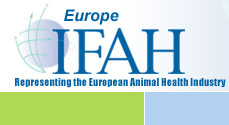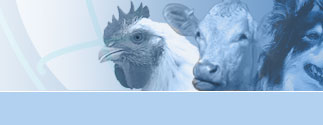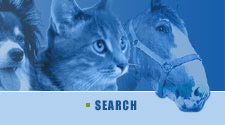|
1. Why are animal health products needed ? |
|
Like humans, our pets and farm animals fall sick, suffer accidents and need protection from disease. In parallel with the science of human medicine, remedies have been used since the earliest days.
Today, a whole range of preventive medicines are available to help the veterinarians and the animal owner prevent and cure diseases. As well as keeping animals healthy it is a fact that healthy animals grow faster and convert their food more efficiently. Some animal health products directly increase the nutritional quality of the animal produce and/or increase production. Other animal health products used on farms help to ensure healthy animal produce.
Certain animal diseases are transmissible to man - either the animal's keeper or the consumer could suffer. Most of these diseases have been brought under control by advances in veterinary science and by the development of animal health products.
|
|
2. Are animal health products safe? |
|
Yes, animal health products are safe. In the EU, animal health products can only be sold for pets or farm animals, if they have been officially approved ("Registered" or "Licensed") by national and/or EU authorities. The basis of approval is the scientific assessment, by independent government appointed experts, of the Safety, Quality and Efficacy of the product.
Safety covers:
* Safety to the animal ;
* Safety to the user (veterinarians, farmers, pet owners) ;
* Safety to the environment ;
* Safety to the consumer.
Quality assessment covers:
* The product's ability to consistently meet approved specifications;
* The design and management of the plant and its quality control procedures;
* The product's storage stability, so that its quality is maintained throughout its life span.
Efficacy shows that scientific evidence exists for the activity claimed.
Confidence in the safety of food from treated animals would undoubtedly be more widespread if the public and those who represent them were more aware of the stringent accuracy to which a product is subjected before being allowed onto the market.
|
|
3. Can the Animal Health Industry unlimitedly release any type of product? |
|
No, animal health products, whether therapeutic, immunological or management tools, must be registered by the national or the European authorities who guarantee their safety, quality and efficacy. A license is only granted after examination of the dossier by the authorities. Currently a company wishing to sell a product in several countries must hand out its dossier according to precise procedures to the authorities of each country. A product is reviewed in terms of safety, quality and efficacy in each country where a license is applied for and the countries may not use the information from each other.
|
|
4. Is the Animal Health Industry properly controlled? |
|
The control of the Animal Health Industry is performed by the national or community institutions. It has been facilitated by the implementation of quality assurance systems in this industry. Quality assurance systems used by the Animal Health Industry require complete and appropriate documentation on each transfer of molecule or product. This documentation can be regularly inspected by the authorities.
|
|
5. What are the safety margins and systems set up to protect the consumer? |
|
As far as animal health products are concerned, it is obvious that the presence of undesirable residues in animal produce must be avoided. To achieve this, the registration files must contain the necessary data to enable the European authorities to establish the Maximum Residue Limits which are authorized. With the advancement of analytical methods in today's world would be impossible to guarantee that no residue of any substance of veterinary medicinal products could ever be detected in animal produce. Though, it has never been proven that a residue of a registered animal health product, used in accordance with the approved instructions on the leaflet, caused harm. ( this residue is so low that it is not harmful to the consumer).
|
|
6. What are the risks linked to our consumption of animal derived food? |
|
The consumer believes that the presence of all sorts of chemical residues is one of the main hazards which threaten him when eating. Experts agree to say that in our Society the major risk is that of overfeeding. After that comes the risk of bacterial or parasitic contamination of food.
The risk of contamination with undesirable residues is insignificant compared to the other two. The risk of residual contamination is directly linked to the possibility of incorrect use or the misuse of unlicensed products. The correct use of registered products before slaughter reduces the risk of incidents.
|
|
7. Which guarantees are offered to the consumer concerning the quality and safety of animal derived food? |
|
Firstly, all partners in the food chain are professionals. Without them it would be impossible to feed the 350 million consumers of Europe correctly. They are undertaking their responsibilities. Secondly, increasingly performing techniques are used by governmental controls in the various steps of production on the farm and in the slaughterhouses, in food processing factories and in restaurants and sales points. Lastly, there is an interdisciplinary control that becomes increasingly stringent and better defined.
|
|
8. Can quality control systems be improved and how? |
|
It is indeed possible to improve quality control systems. The starting point is to define good practices. The practices of each sector of the food chain must be integrated and have the common objective of ensuring that the product delivered to the next partner downstream in the food chain is wholesome. The communication between professionals and the consumers could also be improved. It is already difficult for the highly specialised professionals to have mutual communication, so how can they improve the communication with the non-specialised consumer on very specialised matters.
|
|
9. What are the choices available for the consumer regarding food of animal origin? |
|
Consumers should be informed about the exertion of their right of choice. Information that is mentioned on the label of the product can help the consumer. This information should be clear and concise, controlled and true. Whether to opt for healthy food of organic origin or wholesome food of classical origin is up to the consumer. Significant processing methods must be mentioned on food labels, such as "pasteurised milk" or "sterilised milk", as well as any other manufacturing processes, changing significantly the product's characteristics.
|
|
10. Is our meat still being produced in a natural way? |
|
The question is: "What is natural?". All meat originates from animals, it is the result of biological and natural production. Animals destined for the production of meat, milk or eggs are being selected very carefully. Today genetic engineering is not being used in animal husbandry . To increase the productivity of reducing input and increasing output, farmers have to practice more modern farming. They use concentrated feed products, silage in winter and all modern, but safe techniques. Artificial insemination is used to increase the number of "suitable" offspring.
|
|
11. What are the effects of growth hormones on the animals and on the quality of their meat? |
|
Cattle-breeders use growth hormones, which are not allowed in Europe, for different profitable purposes. The treated cattle converts the food better in meat, thus a treated animal needs less kilo's of food to gain weight than an animal that has not been treated. In this way, the farmer is making a considerable saving of costs in his food supply. Treated cattle also gain quicker in weight than untreated animals. This means that the treated cattle needs less time to reach their slaughtering weight, so the farmer can have savings in work, loans and standing charges. Some growth hormones provide the food to be converted in meat without fat. This fat-reducing effect is very positive for the cattle-breeder, as it increases the trade and value of the animal and because the consumer is asking for more fat-free meat.
Concerning the effect of growth hormones on the quality of meat, we can say that they do not affect the quality of meat if the hormones are administered under controlled conditions (doses, time of administration, age of the animal, waiting period before slaughtering)
Because European law does not allow the use of growth hormones and other parts of the world do allow it (they have approved safe products), European farmers are at a disadvantage.
|
|
12. Which animal diseases are transmissible to humans through meat? |
|
Diseases that can affect both humans and animals are called zoonotic diseases. Next to direct contamination, humans can also be affected by eating meat from an infected animal. That is why zoonotic diseases are being researched very thoroughly. Some zoonotic diseases are caused by parasites, others are caused by micro-organisms. A frequent zoonotic disease caused by a bacteria, is salmonella. Salmonella-infections are better known as food poisoning. Humans can get it because of eating minced raw meat or insufficiently heated meat. It can also arise by drinking contaminated drinking-water, eating raw eggs or just by direct contamination of children by their pets. In addition to some other contaminated animal diseases, swine fever is not a zoonotic disease. Humans can not get this disease through contact with animals, neither by eating contaminated meat. Though, it is important to eliminate the contaminated animals. The OIE (Office International des Epizooties = the world animal health organisation) is devoting a lot of effort to this aim. Despite new diseases that are always a threat, the success of elimination has provided us with safe meat.
|
Back |


